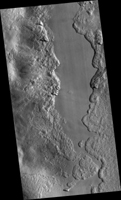
Map Projected Browse Image
Click on image for larger versionThis area, on the western edge of Milankovic Crater on Mars, has a thick deposit of sediment that covers a layer rich in ice. The ice is not obvious unless you look in color.
In the red-green-blue images that are close to what the human eye would see, the ice looks bright white, while the surroundings are a rusty red. The ice stands out even more clearly in the infrared-red-blue images where it has a striking bluish-purple tone while the surroundings have a yellowish-grey color.
The ice-rich material is most visible when the cliff is oriented east-west and is shielded from the sun as it arcs through the sky to the south.
The map is projected here at a scale of 25 centimeters (9.8 inches) per pixel. (The original image scale is 30.8 centimeters [12.1 inches] per pixel [with 1 x 1 binning]; objects on the order of 93 centimeters [36.6 inches] across are resolved.) North is up.
The University of Arizona, in Tucson, operates HiRISE, which was built by Ball Aerospace & Technologies Corp., in Boulder, Colorado. NASA's Jet Propulsion Laboratory, a division of Caltech in Pasadena, California, manages the Mars Reconnaissance Orbiter Project for NASA's Science Mission Directorate, Washington.

